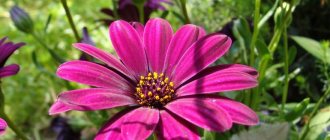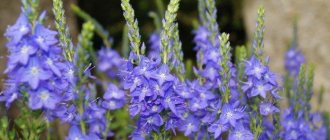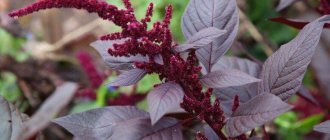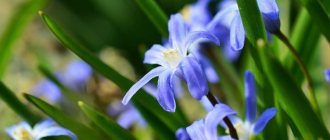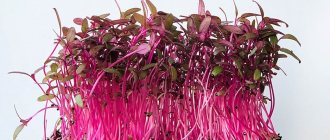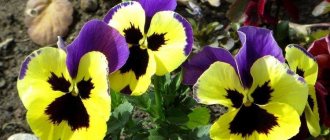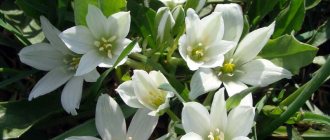Scilla (lat. Scilla) is a perennial plant, a representative of the Asparagus family. Although in some reference books it is classified as a member of the Liliaceae or Hyacinthaceae family. The second name, Scylla, translated from ancient Greek means “young onion”. The flower is also popularly called blue snowdrop.
The habitat of the blueberry is so wide that it can be found not only in Europe and Asia, but also in African countries. In total, there are about 80-90 species of this plant, and in the former USSR alone there are more than 17 species.
Scilla has gained popularity among gardeners due to its ability to adapt to any climatic conditions and ease of care. It feels great in dark places, gets along with other flowers and shrubs without problems and does not require replanting for 6-8 years. It is undemanding in forcing; it can be used as a garden or potted crop.
general description
Scylla belongs to the category of low-growing bulbous plants with 1-3 peduncles. The average height is 10-30 cm. The leaves have a linear or lanceolate shape, extending straight from the soil, disintegrating opposite to each other from the middle of the flower. The flowers themselves are collected in a racemose inflorescence, which, depending on the species, can consist of single or multiple flowers with a diameter of 102 cm. The color varies from white and white-blue to blue and pink.
The fruits are three-lobed capsules containing small seeds inside. The bulbs are covered with thin scales and have an ovoid configuration, usually not extending beyond the boundaries of 1.5-2.5 cm in diameter. Flowering begins in early spring and continues for 1-2 weeks. There are species that bloom in summer and even in autumn.
Interestingly, the blueberry is capable of changing the position of its leaves depending on temperature conditions and daylight hours. On cold, cloudy days, characteristic of the beginning of the growing season, the leaves are “laid out” horizontally to the soil, simultaneously absorbing scattered radiation. In sunny weather, on the contrary, they rise up almost vertically, located along the stem. At the tips of the leaves you can see a semblance of a tip - a hard growth, with the help of which the plant makes its way through the crust of snow and ice, as well as frozen ground.
Possible difficulties:
In caring for non-winter-hardy scylla species, the necessary measures are ventilation, keeping the plants in a lighted place, and observing the temperature regime. S. peruviana gets sick from stagnant air, which negatively affects flowering and the general condition of the plant. S violacea grows as an evergreen.
In low-light places, the plant stretches out and loses its decorative effect. If there is insufficient lighting, the color of the leaves may fade.
If the substrate is too wet, plant roots can be damaged by fungus gnat larvae.
Sometimes the tips of scylla leaves begin to dry out prematurely, which indicates a lack of potassium or phosphorus in the soil. In this case, a number of authors advise watering the soil with a solution of potassium permanganate (2 g per 1 liter of water), and after a few days - with infused superphosphate (3-5 g per 1 liter of water).
Main types
Among landscape designers and amateur gardeners, the following types are most popular:
- Scilla bifolia. It grows throughout the European part of Russia, Crimea and Mediterranean countries. The height of the bush does not exceed 15 cm, the number of stems-peduncles can reach up to 3 pieces, on each of which a whole cap of flowers is “attached”, emitting a pleasant fragrant aroma. This variety of scylla is considered the most abundantly flowering; flowering begins in mid-April and continues until early May.
- Bell-shaped scilla. The second name is Spanish endymion. The habitat is concentrated in Western Europe (Portugal, Spain), as well as the forests of France. The flowers are bell-shaped and slightly curved outward. One peduncle usually contains 4-5 “bells” of blue, pinkish-white or light blue. The bush itself grows to a height of 20-30 cm. Due to its heat-loving nature, the plant requires additional shelter for the winter.
- Siberian scilla. The flowers have a simple, uncomplicated shape and are sensitive to sunlight - they open in the morning and close their petals at night. There are Siberian, Armenian and Caucasian subspecies. Flowering occurs at the beginning of April and lasts 2-3 weeks.
- Peruvian scilla. A fairly tall plant, reaching a height of 30-35 cm. The width of the leaves is 1.5 cm. At the same time, several long arrows can form at once, on which inflorescences of a bright blue hue are fixed in a dense ball. Each bush has up to 50-60 small buds.
Bifolia
Campanulate
Siberian
Peruvian
Fertilizers
Although mother species of scilla growing in the wild are unlikely to receive additional fertilizer, garden species do need it. If you want to get a strong plant with abundant and long-lasting flowering that is not susceptible to disease, feed it.
The most suitable time for feeding is, of course, the beginning of spring, before the sap begins to flow. This process can be done in late autumn.
No special fertilizers are required. A standard mineral set of nitrogen, potassium and phosphorus is quite suitable. For autumn feeding it is better to choose granular types of fertilizers, for spring - liquid ones.
Rare species
The following types of Scylla are quite rare in open sale. Basically, they can only be ordered in specialized flower catalogs:
- Spanish. A bulbous perennial with a strong stem system. In active growth, it reaches a height of up to 40-60 cm. It grows quickly, filling flower beds and the free garden perimeter. Originally from Portugal. The flowers clearly resemble bells, collected in clusters and evenly distributed along the length of the stem.
- Natalskaya. Tall perennial (up to 120 cm), native to South Africa. Fleshy, tight stems are strewn with violet-blue, white-pink and blue flowers with a diameter of 1.5-2 cm. Leaves in the amount of 4-8 pieces during flowering slow down their growth, remaining at the level of 15-20 cm, and then reach a length of 40-40 cm. 60 cm.
Spanish
Natal
general information
Scilla or scilla is a classic bulbous perennial with all the attendant features. Oddly enough, it belongs to the asparagus family, but previously it was classified as a lily plant. Due to the constant confusion in popular nicknames, Scylla is often confused with snowdrops and woodworts.
In nature, blueberries prefer meadows and plains, and are found throughout our continent and even in Africa. Scillas germinate quickly, with the apical inflorescences blooming simultaneously with the growth of long linear leaves. The flowers resemble blue bells and delight with their beauty at the very beginning of spring.
Photo: zvezdagukovo.ru
Rules for disembarkation and departure
Being one of the cold-resistant plants that do not require light, the grass grows well in both shady and illuminated areas. Before planting, the soil must be well dug up, cleared of weeds and moistened. Preference is given to loamy or sandy loam soil with a large amount of organic matter. It is desirable that the composition include leaf humus and complex mineral components.
The soil is prepared in approximately the same way as for daffodils and tulips. Garden soil is mixed with forest soil, containing fine, semi-decomposed tree bark and leaves. At the output, it is necessary to achieve an acidity level in the range of 6.6-7.0. The holes are made at a distance of 5-10 cm from each other. Flower bulbs go 6-8 cm deep into the soil, depending on the variety and size of the planting material.
Since scylla belongs to the category of unpretentious plants, it can be replanted even during flowering. This is usually done in mid-June.
The basic rules of care are as follows:
- For watering, it is better to choose the morning hours, when the sun is not yet too active. To avoid loss of external decorativeness, you need to ensure that water does not “hit” the buds.
- Periodically, the soil should be loosened to a depth of 20-25 mm. To ensure that fewer weeds grow between the rows, you can cover open areas of soil with a layer of leaf humus.
- The main feeding is done in the spring, before flowering. Any complex fertilizer for bulbous plants is suitable. For species that bloom in autumn, the feeding procedure is shifted to the end of summer. It is desirable that fertilizers also include microelements: magnesium, calcium, copper.
- It is better to remove dried buds after flowering before seed pods form on them. Otherwise, Scylla can “take over” the site, reproducing by self-sowing.
- Additional shelter for the winter is not required. Except when the scillas are transplanted in the fall. Then it is recommended to make a pillow of spruce branches or dry leaves on top.
Optimal location
Siberian blueberry loves the sun, but also grows well in partial shade. The main thing is that it is not a too dry place with scorching sun all day long, otherwise it will disappear. Swampy and waterlogged areas are also not suitable for it. When planting for early flowering, it is better to choose places on the southern slopes. Shady areas delay the flowering period.
Reproduction
A flower can reproduce in three ways:
- Seeds. Seed boxes are collected at the end of summer and dried in a bright, well-ventilated area. Preference is given to light yellow boxes with veins and cracks. Due to the short period of similarity, seeds are sown in the same year, in the fall.
On fertilized, dug up soil, shallow grooves (~5 cm) are made into which the seeds are poured and trampled down with soil. They germinate the following spring, the first flowering occurs after about 2-3 years.
- Bulbs. Mother bulbs are dug up when the upper foliage has completely withered and died. After drying and calibrating, they are placed in damp peat or sand to prevent drying out. Planting is done in late August-early September in prepared holes 3-5 cm deep. Flowering usually occurs in the second year.
The depth of the bulbs is equal to their height. Accordingly, the larger the seedling, the deeper it needs to be rooted into the ground. When determining the distance between plants, they again focus on the size of the bulbs - it should be 20-50% larger than the size of the head.
- Self-sad. Scilla can reproduce not only culturally, but also randomly over the entire area of the site. When ripe, the seed pods crack, the seeds are carried by the wind and germinate in a place convenient for them.
Forcing bulbs at home
Growing blueberries in decorative pots at home is not difficult. The main thing is to adhere to a certain scheme of actions:
- For indoor planting, large bulbs with a diameter of 2-2.5 cm are selected. They must first rest for about two months in different temperature conditions: in August - at a temperature of 20 ° C, in September - 17-18 ° C.
- Planting takes place in early October. A substrate consisting of equal parts of sand, leaf soil, turf, sand is poured into prepared containers (pallets, pots), and then the bulbs are placed in it to a depth of 3-5 cm. The number of heads is calculated based on the size of the pot - approximately 5-7 pieces per diameter 12 cm.
- The containers are placed in a cool and not too lit place for rooting. Over the course of 2.5-3 months, they slowly settle, the root system develops and the flower forms. The temperature in the room (pantry, basement, garage) should not exceed 5-10 °C.
- The pot is moved to a warmer and brighter place. The temperature range corresponds to 12-16 °C. The blueberry begins to actively “grow” and blooms after 25-30 days. In a flowering state, it is necessary to regularly but moderately water the soil, and also feed it every two weeks with mineral fertilizers.
Landing
Delicate scylla bells feel great both in sunny meadows and in the shade of bushes and trees. This plant is very unpretentious, but does not tolerate acidic soils. Before planting blueberries, you need to prepare the soil in a special way: mix the soil with peat and wood ash.
Spring blueberry bulbs are planted in pre-prepared holes to a depth of about 2-3 cm in the second half of July. Autumn species are best planted in open ground in early September. Before you buy scilla bulbs, you should carefully inspect them.
If there are defects, stains, or deformed areas, it is better not to buy such a product. Before planting, the bulbs should be kept in a weak solution of potassium permanganate for several hours to better preserve the planting material.
Like all bulbous plants, scilla does not tolerate waterlogging of the soil, so you need to choose a dry, well-drained place for planting.
Diseases and pests
Despite its unpretentiousness and natural “immunity,” blueberries are also susceptible to various diseases. The most common of them are the following:
- Rot. The causative agents of the disease are sclerotinia, sympotia and fusarium fungi. First, the leaves are affected, starting to turn yellow, wither and subsequently fall off. The infection then penetrates into the bulb itself, as evidenced by the appearance of yellow spots. As a result, the bulb hardens and dies. Scillas affected by rot must be dug up and burned. If the disease is discovered during storage of the bulbs, the plaque is removed from them, and the problem area is treated with wood ash.
- Achellenchoides. The disease can be determined visually - the plant begins to lag behind in development and lose its decorative effect. At the same time, both the ground crown and root system are affected. Necrotic spots are clearly visible on the bulbs. In this case, it will no longer be possible to save the flower; it must be dug up and burned so as not to infect the neighbors. For prevention, healthy bulbs are recommended to take so-called “hot baths”. They are placed in water with a temperature of 42-44 ° C and kept for about half an hour.
- Meadow root mite. The pest larvae “gnaw” the bulbs, climbing into the middle and feeding on their juice. As a result, the plant begins to wither, rot, dry out and soon dies. To combat ticks, various insectoacaricides are used: Actellik, Akarin, Agravetin, etc. For preventive purposes, before planting, the bulbs are treated with these drugs and only then planted in the ground.
- Mouse-like rodents. Voles and house mice are among the main enemies of blueberries. They love to feast on sprouted young flower stems and also nibble on bulbs, after which the plants begin to get sick and disappear. The only way to avoid rodent attacks is in a drastic way - with the help of poison, which is placed in grooves dug around the perimeter of the flowerbed.
Scillas – photo
And so that no one ever confuses scillas with other primroses again, we have collected a large photo gallery of them!
Photo: flo.discus-club.ru
Photo: podruga.www.nn.ru
Photo: es.m.wikipedia.org
Photo: sladkiyson.net
Photo: pinterest.ru
Photo: cvetyphoto.blogspot.com
Photo: plantarium.ru
Photo: liveinternet.ru
Photo: culture.ru
Photo: wallbox.ru
Photo: culture.ru
Photo: na-dache.pro
Photo: tvplaneta.ru
Photo: oir.mobi Photo: zen.yandex.ru
Photo: zen.yandex.ru
Photo: planetalsad.com
Photo: cveti-rasteniya.ru
Photo: tsvety-bukety.ru
Photo: stridvall.se
Photo: mirnadivane.ru
Photo: pinterest.ru
Photo: wallbox.ru
Photo: cvetyphoto.blogspot.com
Photo: commons.m.wikimedia.org
Did you like the post? Subscribe to our channel in Yandex.Zen, it really helps us in our development!
